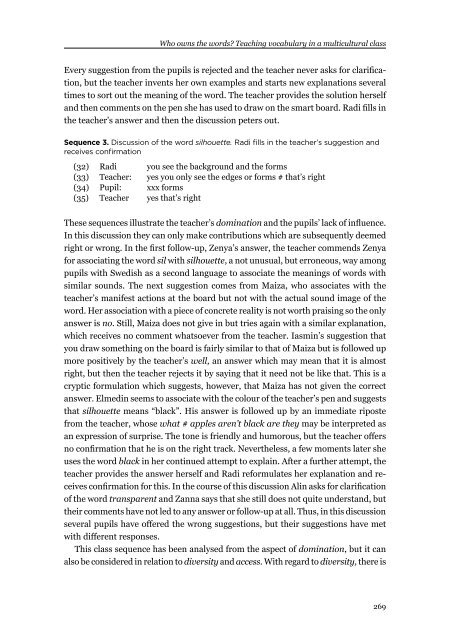Download issue - Umeå universitet
Download issue - Umeå universitet
Download issue - Umeå universitet
You also want an ePaper? Increase the reach of your titles
YUMPU automatically turns print PDFs into web optimized ePapers that Google loves.
Who owns the words? Teaching vocabulary in a multicultural class<br />
Every suggestion from the pupils is rejected and the teacher never asks for clarification,<br />
but the teacher invents her own examples and starts new explanations several<br />
times to sort out the meaning of the word. The teacher provides the solution herself<br />
and then comments on the pen she has used to draw on the smart board. Radi fills in<br />
the teacher’s answer and then the discussion peters out.<br />
Sequence 3. Discussion of the word silhouette. Radi fills in the teacher’s suggestion and<br />
receives confirmation<br />
(32) Radi you see the background and the forms<br />
(33) Teacher: yes you only see the edges or forms # that’s right<br />
(34) Pupil: xxx forms<br />
(35) Teacher yes that’s right<br />
These sequences illustrate the teacher’s domination and the pupils’ lack of influence.<br />
In this discussion they can only make contributions which are subsequently deemed<br />
right or wrong. In the first follow-up, Zenya’s answer, the teacher commends Zenya<br />
for associating the word sil with silhouette, a not unusual, but erroneous, way among<br />
pupils with Swedish as a second language to associate the meanings of words with<br />
similar sounds. The next suggestion comes from Maiza, who associates with the<br />
teacher’s manifest actions at the board but not with the actual sound image of the<br />
word. Her association with a piece of concrete reality is not worth praising so the only<br />
answer is no. Still, Maiza does not give in but tries again with a similar explanation,<br />
which receives no comment whatsoever from the teacher. Iasmin’s suggestion that<br />
you draw something on the board is fairly similar to that of Maiza but is followed up<br />
more positively by the teacher’s well, an answer which may mean that it is almost<br />
right, but then the teacher rejects it by saying that it need not be like that. This is a<br />
cryptic formulation which suggests, however, that Maiza has not given the correct<br />
answer. Elmedin seems to associate with the colour of the teacher’s pen and suggests<br />
that silhouette means “black”. His answer is followed up by an immediate riposte<br />
from the teacher, whose what # apples aren’t black are they may be interpreted as<br />
an expression of surprise. The tone is friendly and humorous, but the teacher offers<br />
no confirmation that he is on the right track. Nevertheless, a few moments later she<br />
uses the word black in her continued attempt to explain. After a further attempt, the<br />
teacher provides the answer herself and Radi reformulates her explanation and receives<br />
confirmation for this. In the course of this discussion Alin asks for clarification<br />
of the word transparent and Zanna says that she still does not quite understand, but<br />
their comments have not led to any answer or follow-up at all. Thus, in this discussion<br />
several pupils have offered the wrong suggestions, but their suggestions have met<br />
with different responses.<br />
This class sequence has been analysed from the aspect of domination, but it can<br />
also be considered in relation to diversity and access. With regard to diversity, there is<br />
269

















